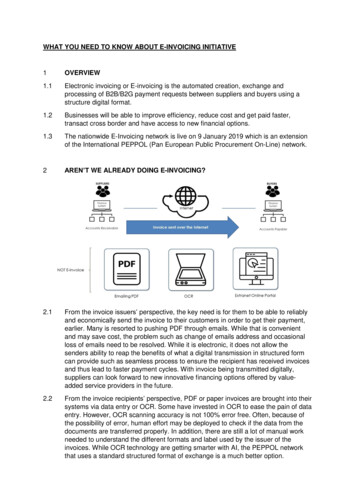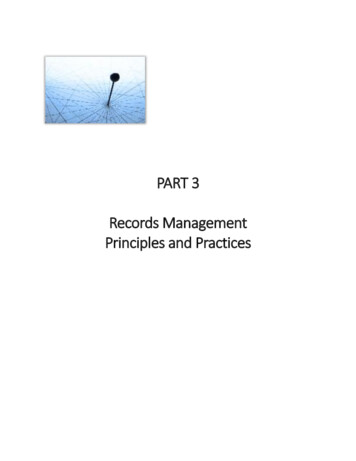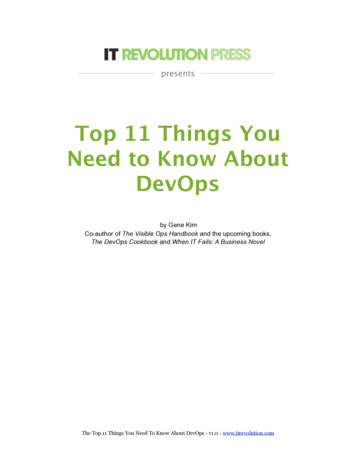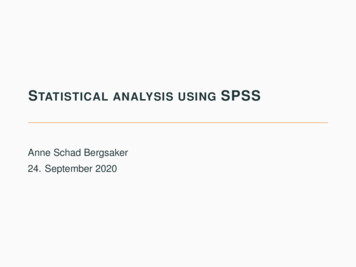
Transcription
WHAT YOU NEED TO KNOW ABOUT E-INVOICING INITIATIVE1OVERVIEW1.1Electronic invoicing or E-invoicing is the automated creation, exchange andprocessing of B2B/B2G payment requests between suppliers and buyers using astructure digital format.1.2Businesses will be able to improve efficiency, reduce cost and get paid faster,transact cross border and have access to new financial options.1.3The nationwide E-Invoicing network is live on 9 January 2019 which is an extensionof the International PEPPOL (Pan European Public Procurement On-Line) network.2AREN’T WE ALREADY DOING E-INVOICING?2.1From the invoice issuers’ perspective, the key need is for them to be able to reliablyand economically send the invoice to their customers in order to get their payment,earlier. Many is resorted to pushing PDF through emails. While that is convenientand may save cost, the problem such as change of emails address and occasionalloss of emails need to be resolved. While it is electronic, it does not allow thesenders ability to reap the benefits of what a digital transmission in structured formcan provide such as seamless process to ensure the recipient has received invoicesand thus lead to faster payment cycles. With invoice being transmitted digitally,suppliers can look forward to new innovative financing options offered by valueadded service providers in the future.2.2From the invoice recipients’ perspective, PDF or paper invoices are brought into theirsystems via data entry or OCR. Some have invested in OCR to ease the pain of dataentry. However, OCR scanning accuracy is not 100% error free. Often, because ofthe possibility of error, human effort may be deployed to check if the data from thedocuments are transferred properly. In addition, there are still a lot of manual workneeded to understand the different formats and label used by the issuer of theinvoices. While OCR technology are getting smarter with AI, the PEPPOL networkthat uses a standard structured format of exchange is a much better option.
2.3There are also a number of organizations that uses an Extranet Online Portal to theirbusiness partners to login and provide clean data. This is more commonly done bybig buyers; though big issuers of invoice may also have a portal. The portal is asingle-sided approach to digitization, mainly benefitting the owner of the portal. It hasits advantages as owners of the portal can customize it to meet their needs.However, there will still be operational overheads in managing login accounts andnot being able to convince some business partners to use the portal. Big buyersowning such portals should consider how invoices can be received through PEPPOLas this will improved productivity with increased invoice accuracy and less manualwork is required due to invoice errors. Dynamic discounts can be explored as well,allowing buyers and suppliers to negotiate discounts based on speed of payment.Big billers owning such portals should consider sending out e-invoices via PEPPOLas it is a surer way for the recipients to capture the data so that payment process canbe quickened.2.4In summary, e-invoice should involve the transmission of data from a supplier in aformat that can be entered into the buyer’s Account Payable system without requiringany human intervention or data input from the buyer’s administrator. By removingpaper and manual processing from your current invoicing process, e-invoicingautomates the process of integration between suppliers and buyers and regardlessof your invoicing software and other business systems.3GENERAL BENEFITS OF E-INVOICINGE-invoicing offers the following main business benefits. Improve Efficiency: Moving from paper to e-invoices will do away to manualdata entry which are error prone. It cuts down the need to resolves errorswhich today involves verifying the information, finding out where the erroroccurred and possibly resolves conflicts internally and externally. Processescan be streamlined when more of such activities are digitalised.Reduce Cost: Moving from paper to e-invoices also eliminates or reducesseveral costs to businesses such as storage and retrieval costs.
Get Paid Faster: E-invoicing can accelerate invoice processing and paymenttimes1. A common standard would allow quicker validation and reducepayment processing delays. According to Enterprise Singapore’s2 SMEFinancing Survey 2017, delays in customer payments was the top financerelated concern. The survey also noted three in five SMEs faced delayedpayments from customers.Transact Cross Border: With the nationwide e-invoicing network, which isglobal, organizations can easily send e-invoices to participating businesspartners overseas and achieve the speed of processing similar to what canbe achieve domestically.Access New Financial Options: E-invoicing allows for accurate and near-realtime visibility of payment cycles. This enables better business sustainabilityand growth through efficient cash flow management. It also has the potentialto enable more efficient supply-chain financing that could increase workingcapital and liquidity.4HOW PEPPOL E-INVOICING WORKS4.1As Singapore’s Companies who wish to adopt e-invoicing must subscribe to acertified 3AP Provider of their choice or PEPPOL Ready Service Providers (such asERP or Accounting solutions on the cloud). Companies then send their e-invoices totheir AP Provider or PEPPOL Ready Service Providers, which checks and verifiesthe receiving company’s PEPPOL address through the 4SMP (address book). TheAP Provider then sends the document to the relevant receiving AP Provider, andthen onward to the receiving party.1A 2017 US Federal Reserve Bank of Minneapolis study indicates that about 92% of e-invoices were paid on time compared to45% of paper invoices.2The survey was conducted in 2017 by SPRING Singapore, now known as Enterprise Singapore, formed as a result of amerger with International Enterprise Singapore on 1 April 2018.3Access Points are the nodes which companies route their documents through. Each AP is run by its own provider.Service metadata publishers are akin to localized address books for PEPPOL’s network. OpenPEPPOL maintains a masterlist.4
5HOW TO GET CONNECTEDThere are three common scenarios to connect to the PEPPOL network.A. Business with own Enterprise SystemMany businesses have their own financial systems where they have digitalise theiraccounts payable and accounts receivable activities. They may also be ERP or SCMtype systems where invoices are created or captured. To connect to PEPPOL fordelivery of e-invoices, these systems will need to be connected to the PEPPOLnetwork via an Access Point. The common way of connecting is via SFTP or API,where the former method is still most popular today.Steps to take:1. Engage an Access Point provider that provides connectivity option2. Include a new field in the Enterprise System for business partners PEPPOL ID(the ID that is required when sending an e-invoice)3. Update the PEPPOL ID on business partner records as they come on-board thenetwork4. Work with the Access Point provider to map the Enterprise System dataset withPEPPOL dataset to establish the run-time mapping capability offered by theAccess Point5. Work with the Access Point provider to establish the data transfer mechanism viaSFTP or API6. Register your Business on the PEPPOL network through your Access Point.Common questions:a) How much will Access Point providers charge for their service? Access Points providing connectivity service usually use a combination ofone-time charge for integration and volume-based tiered pricing for einvoice transactions. Obtain the pricing from the Access Point providers.
B. Business using Service Provider’s solutionThere are increasing number of businesses, particularly the SMEs, using cloudbased hosted Enterprise Systems where invoices are generated or captured forprocessing. These systems will need to be connected to the PEPPOL network viaan Access Point. Since the system is owned or managed by the Service Providersor their technology partners, the activity to establish the connection is carried outby them.Steps to be taken by Service Providers or their technology partners:1. Engage an Access Point provider that provides connectivity option.(Alternatively, become an Access Point provider by working directly with IMDA.Contact us at einvoice@imda.gov.sg for more information.)2. Include a new field in the Enterprise System for business partners PEPPOL ID(the ID that is required when sending an e-invoice)3. Work with the Access Point provider to map the Enterprise System datasetwith PEPPOL dataset to establish the run-time mapping capability offered bythe Access Point.4. Work with the Access Point provider to establish the data transfer mechanismvia SFTP or API.Steps to be taken by businesses:1. Check with your service provider the required activation process. This maydiffer amongst the service providers, both in process and commercial terms.2. Update the PEPPOL ID on business partner records as they come on-boardthe network3. Learn from the Service Provider how to issue e-invoices4. If your service provider is not PEPPOL Ready, check with them their roadmapand plan accordingly.
C. Business without an Enterprise Solution (or chooses not to integrate withtheir Enterprise Solution)Some businesses, particularly the SMEs, may not have embarked on theirdigitalisation journey with any Enterprise System. There are Access Providersoffering Light Weight System at very low cost. The Light Weight System istypically a cloud-based system providing you the ability to enter invoiceinformation to send to the network and receiving capability for your businesspartner to send e-invoices to you. There will also be a simple customer/vendordatabase for you to maintain online.Steps to be taken by businesses:1. Find out more from Access Points offering Light Weight System.2. Sign up an account. The on-boarding process will take you through thenecessary steps to register your PEPPOL ID.3. Update the PEPPOL ID on business partner records as they come on-boardthe network4. Learn from the Service Provider how to issue e-invoices6IMDA AS A PEPPOL AUTHORITY6.1Following an evaluation of e-invoicing standards, IMDA implemented the PanEuropean Public Procurement On-Line (PEPPOL) e-invoicing standard, makingIMDA the first National PEPPOL authority outside of Europe, and the first NationalAuthority in Asia, to adopt the standard. IMDA and OpenPEPPOL signed a letter ofappointment in May 2018 to formalize IMDA as the National PEPPOL Authority inSingapore.6.2Singapore’s network was launched on 9 January 2019. Enterprises and technologysolution/service providers are now able to join the network to enjoy the benefits of EInvoicing. Service providers can now bring on-board their corporate customers.6.3The following are the key characteristics of PEPPOL: An open standard intended to bridge interoperability across competing businesssolutions;
Tried and tested standard, handling millions of transactions across Europe;Clear technical and legal frameworks at national and international levels;The capability to “connect once, connect to all” – the ability to deal with any otherbusiness on the network seamlessly; andA single and standardized means of issuing and receiving e-invoices with otherson the PEPPOL network6.4The PEPPOL standard is maintained by OpenPEPPOL, a non-profit internationalassociation. It was conceived in the European Union in 2008, with OpenPEPPOLestablished in 2012. In May 2018, it has 311 members from 32 countries, with 209Access Points in 26 countries in Europe, North America and Asia, that serve toconnect over 150,000 entities. PEPPOL conducted over 90 million transactionsbetween the Access Points in 2018.6.5As of May 2018, there are more than 10 other PEPPOL Authorities in Europe, mostlyrun by their respective public sectors. They are: Belgium, Denmark, Germany,Ireland, Italy, Netherlands, Norway, OpenPEPPOL AISBL, Poland, Sweden and theUK.6.6As Singapore’s PEPPOL Authority, IMDA sets the national rules and specificationsthat meet Singapore’s domestic requirements. It has appointed Singapore NetworkInformation Centre (SGNIC) Pte Ltd as the Service Metadata Publisher and hascertified more than ten PEPPOL Access Point (AP) providers to date. IMDA will alsoensure their conformance to the PEPPOL technical and service standards.Find out more on how you can digitalize your business network withE-Invoicing at einvoice@imda.gov.sg!
WHAT YOU NEED TO KNOW ABOUT E-INVOICING INITIATIVE 1 OVERVIEW 1.1 Electronic invoicing or E-invoicing is the automated creation, exchange and . transact cross border and have access to new financial options. 1.3 The nationwide E-Invoicing network is live on 9 January 2019 which is an extension of the International PEPPOL (Pan European Public .











